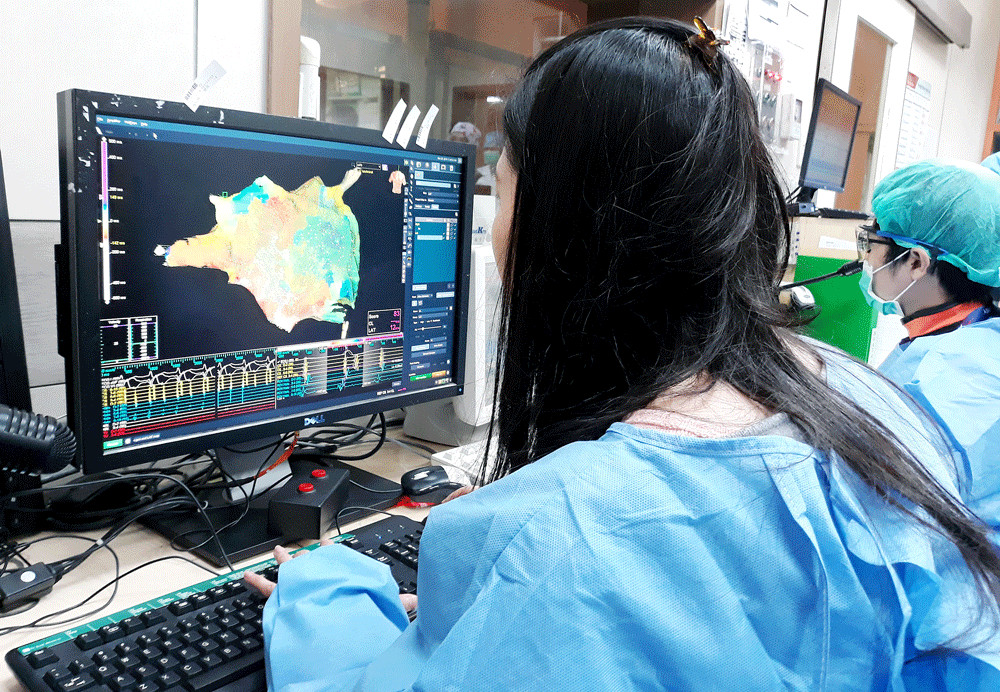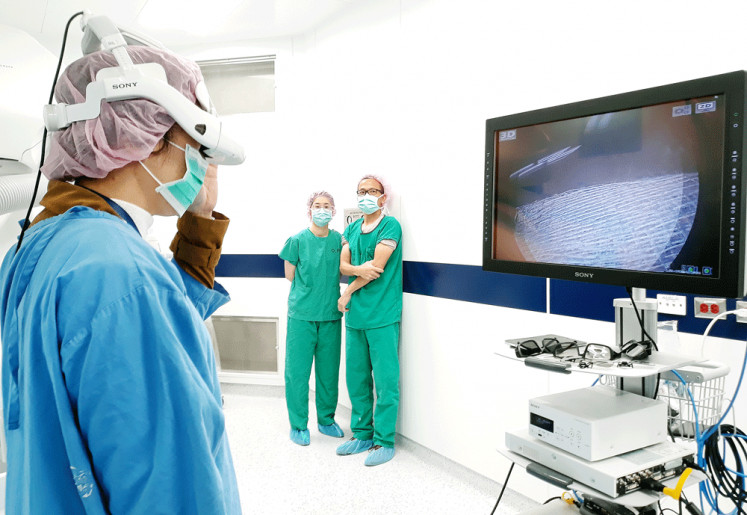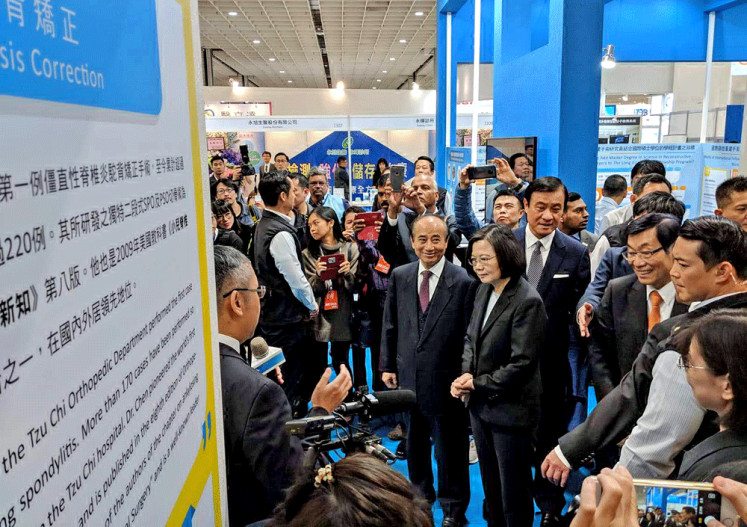Taiwan's advanced medical technology gives patients new hope
With its advanced technology and cutting-edge procedures, Taiwan has become one of Asia’s go-to medical tourist destinations.
Change Size
 Mapping the heart: A doctor at Taipei Veterans General Hospital uses a 3D mapping system during a catheter ablation procedure to precisely identify the source of the patient’s arrhythmia. The catheter emits a pulse of painless radiofrequency energy that destroys the abnormal tissue and corrects the heart beat. (The Jakarta Post/Callistasia Anggun Wijaya )
Mapping the heart: A doctor at Taipei Veterans General Hospital uses a 3D mapping system during a catheter ablation procedure to precisely identify the source of the patient’s arrhythmia. The catheter emits a pulse of painless radiofrequency energy that destroys the abnormal tissue and corrects the heart beat. (The Jakarta Post/Callistasia Anggun Wijaya )
I
t was after a near-death experience that Ron Jovi, 35, a Filipino man who is now a Taiwanese citizen, understood that every breath was a blessing and life was a miracle he often took for granted.
Sitting on a hospital bed at Tri-Service General Hospital in Taipei one late November morning, Ron smiled at Dr. Chi-Tun Tang, whom he calls his savior.
Dr. Tang, the hospital’s chief of neurosurgery, observed the sutures on Ron’s head — the result of an operation to lift an egg-sized tumor nesting on his brain. The doctor said Ron’s skin would be swelling for a couple of days, but he shouldn’t be worried because it was normal after surgery.
Again and again, Ron thanked Dr. Tang for removing the tumor.
Always focusing on his work and his goal to buy his dream house in Taiwan, Ron was unaware that he had lived with a tumor for more than 10 years until he started having seizures and collapsed several times. In early October, he was shocked to be diagnosed with a deadly brain tumor.
It was in the third week of November that Ron underwent a 14-hour surgery at Tri-Service General Hospital, which is known for its excellent neurological department.

“I remember before the surgery, Dr. Tang told me to put my trust in him and that was what I did,” Ron said.
The surgery went well and slowly but surely, Ron was on his way to recuperating. Like a little boy who just learned how to walk, Ron was overjoyed that he could walk without any help only four days after the surgery.
“I now believe that miracles do happen,” he said.
Aiming to be the next Asia’s medical hub, Taiwan has equipped its hospitals with the most advanced medical technology.
The Taiwanese government helps both public and private hospitals that have passed the state’s accreditation in procuring cutting-edge medical equipment in a bid to promote Taiwan as a medical tourist destination, keeping apace with other Asian countries like, Singapore, Malaysia and Thailand.
Tri-Service General Hospital, for instance, uses 3D Virtual Reality (VR) Neuronavigation for brain surgeries. VR, which gained popularity for its use in video games, is utilized for intraoperative monitoring and navigation systems.

The technology was applied in Ron’s brain surgery, considering that his case was quite challenging and involved a big tumor intermingling with blood vessels and nerves. Dr. Tang used the system to help him get a better image and real-time monitoring of Ron’s critical neural structure.
Similar technology is also applied to neurospinal surgeries. By using an O-arm imaging system, surgeons can see real-time 3D images of a patient’s spine during surgery.
“The procedure has a 98 percent accuracy rate, with a revision rate of 2 percent,” said Dr. Tzu-Tsao Chung from the hospital’s neurosurgery department.
Another hospital, Taipei Veterans General Hospital, emboldens its excellence in treating patients with irregular heartbeats, called arrhythmia, through a radiofrequency ablation technique. Doctors use a 3D mapping system during the catheter ablation to precisely identify the source of the arrhythmia.
“In the past, we had to cut into the heart to map its irregularities. Now, the 3D mapping system helps us do that [in a less invasive way],” said Dr. Yenn-Jiang Lin, the hospital’s chief of cardiology.
During the procedure, the tip of a catheter is guided under X-ray fluoroscopy to an area of heart tissue that is producing abnormal electric signals. The catheter then emits a pulse of painless radiofrequency energy that destroys the irregular tissue and corrects the heartbeat.
Meanwhile, the China Medical University Hospital (CMUH) in central Taiwan’s Taichung City marked a notable achievement while treating a patient suffering from lower-limb lymphedema, a disease that causes one’s leg to swell up to the size of an elephant’s.
Loan, a 13-year-old girl from Vietnam, underwent surgery in the CMUH to get a normal-sized left leg in 2016. Now, she can wear normal-sized shoes and ride a bicycle again.

The quality of service offered by Taiwan’s hospitals was acknowledged by Siswadi, 59, an Indonesian citizen working in Taipei who receives outpatient treatment for blood coagulation and a pinched nerve in his tailbone at the Taipei Veterans General Hospital.
Siswadi said, besides the hospital’s advanced technology, the doctors always treated him with great care and friendliness.
“I see that the doctors here always give an accurate diagnosis of my illness. I think Taiwan can be one of alternative [medical destinations] for Indonesian patients,” he said.
Taiwan promotes medical services as a part of its New Southbound Policy, which calls for the development of comprehensive relations with countries in ASEAN, South Asia, Australia and New Zealand.
Last year, 103,241 foreigners came to Taiwan to receive medical treatment, with Indonesian patients accounting for 24 percent.
As of August this year, the number of Indonesian patients has reached 26 percent of the total 100,373 international patients.
So far, 14 hospitals in Taiwan have been accredited by Joint Commission International (JCI), an international accreditation for healthcare quality and patient safety.
Taiwan External Trade Development Council official Walter Yeh said Taiwan offered smart medical solutions to patients at affordable prices.
“The medical costs are half than [those in] Singapore and close to the [price of medical care] in Malaysia,” Walter said.

Mecca of doctor training programs
In the past, a lot of doctors from the Eastern world would seek new skills and knowledge in Western countries. What is trending now appears to be the other way around.
Dr. G. Di Taranto from Italy is one of the foreign doctors who flew to Taiwan to master the latest medical technology and procedures.
Following a recommendation from his seniors, Taranto went to the China Medical University Hospital (CMUH) in Taichung to learn advanced reconstructive microsurgery for a year.
He chose the hospital because of the reputation of its International Medical Service Center superintendent, professor Hung-Chi Chen, who is often referred to as one the most important plastic surgeons in the world.
Under the Training the Trainers program supported by the Taiwanese government, Taranto hopes to train fellow doctors in his country about the new knowledge he gained in Taiwan.
Throughout the year, more than 100 physicians from 26 countries have come to CMUH for integrated reconstructive microsurgery training programs.
“The hospital [CMUH] applies a great level of technology. The IT [information technology] system is incredible and efficient,” Taranto said during the 2018 Taiwan Healthcare Expo at the Nangang Exhibition Center on Nov. 29.
Taranto said he planned to bring home a 3D microscope used in the CMUH as the tool had yet to be used in his country.
Meanwhile, Rafael Denadai, a surgeon from Brazil, said he was satisfied with the training program at the Linkou Chang Gung Memorial Hospital, which is known for its expertise in craniofacial reconstructive surgery for cleft lips and palates and jaw deformity, among others. He particularly applauded the program for providing hands-on training with the guidance of local professors.
Denadai said the hospital was well-known in his country and he believed the training would be beneficial for his career.
As of 2018, 828 physicians have been trained in the Craniofacial Center of Chang Gung Hospital.
Taiwan’s Ministry of Health and Welfare recorded that from 2014 to October 2018, around 2,700 foreign doctors, particularly those from Europe, the United States and Asia, had joined the training programs in several hospitals in Taiwan. Among them are 124 Indonesian doctors.
“We want to keep learning by teaching [international trainees],” said Yueh-Ping Liu, a senior technical specialist at the ministry’s medical affairs department.
_________________________
The Taiwan External Trade Development Council (TAITRA) recently invited The Jakarta Post to go on a three-day medical tourism trip to Taipei and several surrounding cities.









